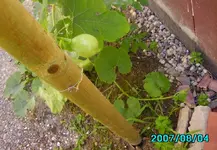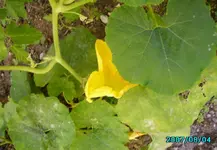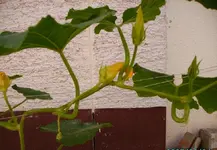Broccoli
UK Garden Centre - Information about Broccoli
Frozen broccoli spears from the supermarket have introduced this vegetable into countless homes, but these green heads are really calabrese, whereas the garden-grown variety is usually purple sprouting broccoli. So there is some confusion which is not helped by the catalogues and textbooks which can’t seem to agree on the correct names to use. Very simply, the word ‘broccoli’ should be restricted to the sprouting sorts which virtually all work on the cut-and-come-again principle. The name ‘winter cauliflower’ should be used for the heading types which form one large white head in winter or spring. The broccolis are sown in spring and planted out in summer and there are three types – calabrese for harvesting in autumn and purple or white for cutting in the following spring. These purple and white types are hardy, high-yielding and fill the gap between the sprouts and the spring cabbages.
Seed facts
Expected germination time: 7-12 days
Approximate number per ounce: 8000
Expected yield per plant: 1 ½ lb (750g)
Life expectancy of stored seed: 4 years.
Approximate time between sowing and cutting: 12 weeks (Calabrese); 44 weeks (Purple and White varieties)
Ease of cultivation: Easier than cauliflower but still not really easy – there is transplanting to do and various troubles to watch out for.
Soil facts
· Broccoli, like other brassicas, can fail in loose and starved soil. Ideally the ground should be firm and rich in organic matter.
· Pick a reasonably sunny site for the place where the plants will grow to maturity. Dig in autumn – work in plenty of well-rotted manure or compost if the soil is poor. Lime, if necessary, in winter.
· In spring apply Growmore fertilizer – rake in Bromophos if cabbage root fly is known to be a problem. Do not fork over the surface before planting the seedlings – tread down gently, rake lightly and remove surface rubbish.
Sowing and Planting
Sow very thinly ½ in (1cm) deep in rows that are 6in (15in) apart. Cover with soil.
· Thin the seedlings to prevent them from becoming weak and spindly. They should be about 3in (7cm) apart in the rows.
· The seedlings are ready for transplanting when they are 3in (7cm) high. Water the rows the day before moving the transplants to their permanent quarters. Plant firmly, setting the seedlings about 1in (2.5cm) deeper than they were growing in the seed bed. Leave 1 ½ ft (45cm) between purple and white sprouting broccoli, 1ft (30cm) between green sprouting broccoli. Water after planting.
Calendar
· The date you can expect to start cutting depends on the variety and the weather. Early Purple Sprouting will be ready for its first picking in January if the winter is mild but mid spring is the peak harvesting period for the purple and white varieties.
· The green varieties will be ready for cutting in autumn – choose Express Corona or Green Comet if you are in a hurry. Cropping will extend into winter if prolonged frosts do not occur.
Sowing time: Usually mid April to mid May; less usually beginning of April to the end of May.
Planting time: Mid June to mid July; can extend from beginning of June to end of July.
Cutting time: Early Varieties: February to the end of March (can start mid January); Late Varieties: Late March to early May – can extend to late May; Green varieties: August to mid October (Can last from late July to early November.)
Looking after the crop
· Hoe regularly and provide some means of protection for the young plants against birds.
· Summer care consists of watering in dry weather and applying a mulch to conserve moisture. Occasional feeding with a liquid fertilizer will improve the crop. Broccoli is a trouble-prone crop so watch for pests. Spray with Crop Saver if caterpillars appear.
· With the approach of winter draw up soil around the stems and stake the plants if the site is exposed. Always firm the stems if they are loosened by wind or frost. Pigeons can be a menace at this time of year – netting may be necessary.
Harvesting
· The time to cut is when the flower shoots (‘spears’) are well formed but before the small slower buds have opened. Once in flower the spears are woody and tasteless.
· Cut or snap off the central spear first – in a few varieties this will be a cauliflower-like head. Side shoots will be produced and these should be picked regularly, but never strip a plant completely.
· The spears are generally 4-6in (10-15cm) long and cropping should continue for about 6 weeks. If you let any of them flower, however, production will stop at an earlier stage.
Varieties
Purple Sprouting varieties
This is the hardiest and the most popular broccoli for growing at home. It is extremely useful for heavy soils and cold areas where little else can overwinter. The heads turn green when cooked. There are three popular varieties – planting all three will give you continuous cropping from January until May.
Christmas Purple Sprouting: The first of the broccolis, appearing in January under favourable conditions and February in a normal season.
Early Purple Sprouting: The most popular variety – ready for cutting in February or March. Prolific and hardy – the one to choose if you plant to grow only one sort of broccoli for spring use.
Late Purple Sprouting: Like the other purples, winter-hardy and robust – plants grow about 3ft tall. The spears will not be ready for picking until April.
Purple Sprouting: Sometimes the seed packet doesn’t tell you whether it is ‘Early’ or ‘Late’. You will find that the spears appear in March and April.
White Sprouting varieties
This group produces small cauliflower-like spears. The varieties are less popular than the purple sprouting sorts but some people prefer the flavour and the white appearance of this crop. If you propose to grow white sprouting broccoli then the choice of variety is very simple – there is just ‘Early’ and ‘Late’.
Early White Sprouting: The one to grow if you want to cut the crop in March and Early April.
Late White Sprouting: Extends the harvesting period for broccoli lovers – spears appear in April and early May.
Calabrese varieties
Calabrese or green sprouting broccoli is a useful but much underrated vegetable. Unlike the purple and white sprouting types, it produces a crop of delicately-flavoured spears and before the onset of winter. Some varieties produce a succession of spears stretching from early autumn until the first frosts – if you want plants which bear a single large head in August then choose Green Comet.
Express Corona: An F1 hybrid – one of the earliest of all the green sprouting types. About 45 days after planting out the central head is ready for cutting – side shoots then freely develop to give a succession of succulent spears.
Green Comet: Another F1 hybrid and another early cropper. Unlike Express Corona, the central head is exceptionally large – up to 7in (17cm) across and weighing about 1lb (500g). There is, however, little spear production after the main head has been cut.
Italian Sprouting: This is the basic variety which has kept its place in some catalogues despite the appearance of modern F1 hybrids. It has an excellent reputation for flavour and a long cropping season.
Corvet: An F1 hybrid which matures in about 60 days after transplanting. It gives you the best of both worlds – the primary head is large and firm, but after its removal there is a succession of secondary spears.Romanesco: Not just another variety – it has two distinctive features. Romanesco is a late cropper, its heads appearing in November, and the flavour is outstanding. The texture is very soft and the lime-green spears should be steamed and served like asparagus.
El Centro: This maincrop variety still keeps its place in a few catalogues, although it does not have the cropping capacity of the F1 hybrids not the flavour of the old favourite Italian Sprouting.
Perennial variety
Perennial broccoli is a tall-growing vegetable – leave about 3ft (90cm) between the plants. In spring or early summer about 8 small and pale green heads are produced, each one looking like a small cauliflower. Grow the variety Nine Star Perennial – plant it against a fence and fork in a general-purpose fertilizer each spring. Apply a mulch in early summer, never let the flower buds open and you will obtain heads year after year.
Troubles
See Brassicas.





